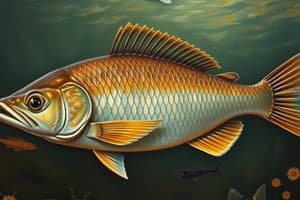Podcast
Questions and Answers
What is the CLASS consisting of 'bony fish'?
What is the CLASS consisting of 'bony fish'?
- Chondrichthyes
- Actinopterygii
- Osteichthyes (correct)
- Agnatha
What is the CLASS consisting of 'jawless fish'?
What is the CLASS consisting of 'jawless fish'?
- Actinopterygii
- Osteichthyes
- Chondrichthyes
- Agnatha (correct)
What is the CLASS consisting of 'cartilaginous fish'?
What is the CLASS consisting of 'cartilaginous fish'?
- Osteichthyes
- Actinopterygii
- Agnatha
- Chondrichthyes (correct)
The SUBCLASS of bony fish that are ray-finned is called?
The SUBCLASS of bony fish that are ray-finned is called?
The SUBCLASS of bony fish that are lobe-finned is called?
The SUBCLASS of bony fish that are lobe-finned is called?
What are examples of Class Chondrichthyes?
What are examples of Class Chondrichthyes?
What are examples of Class Agnatha?
What are examples of Class Agnatha?
What are examples of Class Osteichthyes?
What are examples of Class Osteichthyes?
What covers the gills on some fish?
What covers the gills on some fish?
Some fish lay eggs outside of the mother's body--these fish are ____.
Some fish lay eggs outside of the mother's body--these fish are ____.
What helps sense movement of other organisms and vibrations in the water?
What helps sense movement of other organisms and vibrations in the water?
What helps the fish maintain buoyancy and can inflate or deflate as needed?
What helps the fish maintain buoyancy and can inflate or deflate as needed?
Some fish give live birth and the embryos get nourishment from their mother--these fish are ____.
Some fish give live birth and the embryos get nourishment from their mother--these fish are ____.
What does it mean if a fish is cold-blooded?
What does it mean if a fish is cold-blooded?
Some fish give live birth but the embryos get nourishment from a yolk sac inside the mother--these fish are ____.
Some fish give live birth but the embryos get nourishment from a yolk sac inside the mother--these fish are ____.
The main reproductive characteristic of most fish is that they are ____.
The main reproductive characteristic of most fish is that they are ____.
The egg-laying behavior of fish is called ____.
The egg-laying behavior of fish is called ____.
Receptors in sharks that allow them to detect bioelectric fields.
Receptors in sharks that allow them to detect bioelectric fields.
What part of Class Chondrichthyes allows the male to transfer sperm to the female?
What part of Class Chondrichthyes allows the male to transfer sperm to the female?
Which of the following statements is true about Class Chondrichthyes? (Select all that apply)
Which of the following statements is true about Class Chondrichthyes? (Select all that apply)
Which of the following statements is true about Class Osteichthyes? (Select all that apply)
Which of the following statements is true about Class Osteichthyes? (Select all that apply)
Which of the following statements is true about Class Agnatha? (Select all that apply)
Which of the following statements is true about Class Agnatha? (Select all that apply)
What is the main feature of Class Agnatha?
What is the main feature of Class Agnatha?
What is one characteristic of many lampreys but not of hagfishes?
What is one characteristic of many lampreys but not of hagfishes?
The two major groups of bony fishes are the __________ and __________.
The two major groups of bony fishes are the __________ and __________.
Where does fertilization occur in cartilaginous fish?
Where does fertilization occur in cartilaginous fish?
What is one of the main features of Class Chondrichthyes?
What is one of the main features of Class Chondrichthyes?
What adaptation do some cartilaginous fishes have to increase buoyancy?
What adaptation do some cartilaginous fishes have to increase buoyancy?
Which of the following ways can sharks locate their prey? (Select all that apply)
Which of the following ways can sharks locate their prey? (Select all that apply)
What does chemoreception refer to?
What does chemoreception refer to?
What does the lateral line system do?
What does the lateral line system do?
What can ampullae of Lorenzini detect?
What can ampullae of Lorenzini detect?
Where does fertilization usually occur in bony fish?
Where does fertilization usually occur in bony fish?
How does a bony fish adjust its buoyancy?
How does a bony fish adjust its buoyancy?
How can fish adjust their density?
How can fish adjust their density?
What is the main purpose of slime on a bony fish?
What is the main purpose of slime on a bony fish?
Flashcards are hidden until you start studying
Study Notes
Fish Classification
- Osteichthyes: Class of bony fish, examples include catfish, bass, and goldfish.
- Agnatha: Class of jawless fish, with examples like hagfish and lampreys.
- Chondrichthyes: Class of cartilaginous fish, includes sharks, skates, and rays.
Subclasses of Bony Fish
- Actinopterygii: Subclass of ray-finned bony fish.
- Sarcopterygii: Subclass of lobe-finned bony fish.
Fish Anatomy and Features
- Operculum: Covers the gills on some fish, aiding in protection and respiration.
- Swim Bladder: Organ that helps fish maintain buoyancy by inflating or deflating.
- Lateral Line System: Sensory system that detects movement and vibrations in the water.
Reproductive Strategies
- Oviparous: Fish that lay eggs outside the mother’s body.
- Viviparous: Fish that give live birth with embryos receiving nourishment directly from the mother.
- Ovoviviparous: Fish that give live birth but embryos receive nourishment from a yolk sac.
- Dioecious: Most fish exhibit separate male and female sexes; reproductive behavior is called spawning.
Temperature Regulation
- Ectothermic: Fish are cold-blooded and rely on external sources to regulate body temperature.
Specialized Structures
- Ampullae of Lorenzini: Receptors in sharks for detecting bioelectric fields.
- Claspers: Modified pelvic fins in male Chondrichthyes for sperm transfer.
Fish Scales
- Types include placoid, ctenoid, and ganoid scales, found in various classes of fish.
Class Characteristics
-
Chondrichthyes:
- Lack operculum, have gill slits.
- Possess placoid scales and no swim bladder.
- Many utilize internal fertilization.
- Can maintain buoyancy by storing lipids and oils.
-
Osteichthyes:
- Possess an operculum and typically use external fertilization.
- Have swim bladders and various scale types (cycloid, ctenoid, ganoid).
-
Agnatha:
- Do not possess scales or jaws, and include both saltwater and freshwater species.
- Many exhibit parasitic behaviors.
Notable Features
- Fertilization in Chondrichthyes: Occurs internally as opposed to Oseichthyes, where most fertilization is external.
- Buoyancy Adjustments: Bony fish adjust buoyancy through the swim bladder by regulating air volume.
Sensing Prey
- Sharks locate prey using:
- Ampullae of Lorenzini for electric field detection.
- Sound waves and chemoreception for smell and taste.
- Lateral line system for vibrations and sight.
Adaptations
- The slime on bony fish provides protection and aids in movement through water.
This study guide captures critical characteristics of different fish classes, their anatomy, reproduction, and adaptations, providing a comprehensive overview for zoology studies.
Studying That Suits You
Use AI to generate personalized quizzes and flashcards to suit your learning preferences.





